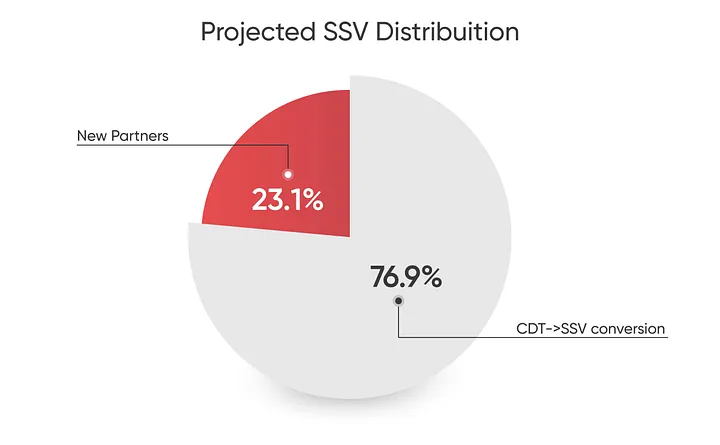บทความ
รู้จักเหรียญ SSV และ ssv.network ปลดล็อก Ethereum Staking ด้วยเทคโนโลยีตรวจสอบความถูกต้องแบบกระจายศูนย์

นับตั้งแต่ Ethereum อัปเกรดมาเป็นระบบฉันทามติแบบ Proof-of-stake (PoS) การทำ staking ได้กลายมาเป็นส่วนสำคัญในการรักษาความปลอดภัยของเครือข่าย แต่อย่างไรก็ตาม แม้จะมีการอัปเกรด The Merge ไปแล้วเมื่อ 15 กันยายน 2022 ผู้ให้บริการ validator node ยังคงต้องใช้ ETH ขั้นต่ำจำนวน 32 ETH เพื่อใช้ในกระบวนการตรวจสอบ ซึ่งเป็นการสร้างอุปสรรคบางประการสำหรับผู้ที่ต้องการเข้าไปมีส่วนร่วมในการเป็น validator
ซึ่งในบทความนี้ เรามาทำความรู้จักกับ ssv.network (SSV) โครงสร้างพื้นฐานสำหรับการ staking แบบกระจายศูนย์ ที่จะช่วยทำให้ผู้คนสามารถเป็นผู้ตรวจสอบผ่านการสร้าง Pool โดยไม่ต้องเป็นผู้ควบคุมแบบเต็มรูปแบบ
ทำความรู้จัก Secret Shared Validator (SSV)
Secret Shared Validator (SSV) เป็นโทเคนมาตรฐานบนเครือข่าย ssv.network มีจุดประสงค์สำหรับใช้เป็นค่าตอบแทนผู้ดูแลระบบ และใช้เป็นสิทธิเพื่อโหวตในกรณีที่มีการเปลี่ยนแปลง ซึ่งเหรียญโทเคนมีบทบาทสำคัญในการดึงดูดชุมชนและกระตุ้นให้ผู้มีส่วนได้เสียที่เหมาะสม มีส่วนร่วมอย่างมีนัยสำคัญต่อเครือข่าย (ssv.network)
ssv.network เป็นเครือข่ายการทำ staking ETH แบบกระจายอำนาจเต็มรูปแบบและเป็นโอเพ่นซอร์ส โดยใช้เทคโนโลยี Secret Shared Validator (SSV)
SSV เป็นที่รู้จักในชื่อ DVT หรือ Distributed Validator Technology หรือภาษาไทยเรียกว่า เทคโนโลยีตรวจสอบความถูกต้องแบบกระจายศูนย์ ให้บริการที่เปิดกว้างและเข้าถึงง่าย ช่วยในเรื่องการแยกส่วน validator หรือผู้ตรวจสอบความถูกต้องบนเครือข่าย Ethereum เพื่อให้เครือข่ายดำเนินการได้อย่างอิสระและหลายตัวพร้อมกัน
การทำงานของผู้ตรวจสอบความถูกต้อง (validator) บนเครือข่าย Ethereum ของ ssv.network ช่วยให้เกิดระบบสำรองแบบ active-active (active-active redundancy) ซึ่งจะช่วยเพิ่มความปลอดภัยให้กับหน่วย validator และยังส่งผลดีกับด้านอื่นๆ ทั้ง ตัวเครือข่าย Ethereum, staking pools (กลุ่มผู้ถือเหรียญที่รวมตัวกันเพื่อนำเหรียญที่ต้องการมาล็อกรวมกันเพื่อสร้างโอกาสในการถูกเลือกเป็นผู้ตรวจสอบธุรกรรมและรับผลตอบแทนมาขึ้น), ระบบให้บริการ staking และ solo stakers
ใครคือผู้สร้าง SSV ?

Alon Muroch เป็น CEO และผู้ร่วมก่อตั้ง ssv.network ร่วมกับ Adam Efrima ผู้ก่อตั้ง Blox.io แพลตฟอร์ม non-custodial ETH staking โดยเปิดตัวอย่างเป็นทางการเมื่อวันที่ 17 กันยายน 2021 ในชื่อ Blox (CDT) ก่อนจะเปลี่ยนเป็น ssv.network
ในช่วงเริ่มต้น Alon Muroch เป็นเพียงผู้ประกอบการและนักพัฒนา เขาเริ่มทำงานให้กับบริษัทสตาร์ทอัพต่าง ๆ มากมายในช่วงทศวรรษที่ผ่านมา ในปี 2014 เขาได้อ่าน White paper ของ Satoshi Nakamoto ผู้ให้กำเนิด Bitcoin ซึ่งเป็นแรงบันดาลใจให้เขาสำรวจและมีส่วนร่วมอย่างลึกซึ้งในโลกของบล็อกเชนและคริปโทเคอร์เรนซี นำมาสู่การมีส่วนร่วมในการพัฒนา Bitcoin, Ethereum และพัฒนา Multi-signature (หรือ Multisig) wallet แบบ P2P จนกระทั่งในปี 2017 เขาได้ร่วมก่อตั้ง Blox.io ทำหน้าที่เป็นประธานเจ้าหน้าที่บริหารของบริษัท
จุดเด่นของแพลตฟอร์ม
ssv.network เป็นมากกว่าเครือข่ายตรวจสอบความถูกต้องแบบกระจายศูนย์ (Distributed Validator Network) มีความสามารถรองรับต่อความผิดพลาดของผู้ตรวจสอบระบบบน Ethereum ช่วยทำให้ผู้ต้องการเป็นผู้ให้บริการ (operator) สามารถเข้าถึงการทำ staking ได้อย่างง่ายดายโดยไม่ต้องเสียค่าใช้จ่ายด้านโครงสร้างพื้นฐาน แม้ว่าผู้ให้บริกาารบางรายจะออฟไลน์ และตัวรางวัลของผู้ตรวจสอบระบบก็ยังสะสมอย่างต่อเนื่อง
สามารถแบ่งจุดเด่นด้านการทำงานของ ssv.network ได้ดังนี้
-ลดอุปสรรคในการทำ Staking : ssv.network ทำหน้าที่เป็นตัวกลางในการปลดล็อคขั้นต่ำของการทำ staking บนเครือข่าย Ethereum ที่ 32 ETH
-ระบบสำรองแบบ active-active redundancy และ Fault Tolerance: การแยก validator หรือผู้ตรวจสอบความถูกต้องของ Ethereum เป็นหลาย KeyShares ทำให้สามารถออกมาดำเนินการอย่างอิสระและทำงานได้หลาย Node พร้อมกัน ดังนั้นถ้าหากระบบเกิดการ offline ไม่ว่าด้วยปัญหาระบบหรือการซ่อมบำรุง ก็ยังสามารถทำงานบน Node อื่น ๆ ได้
-Non-Custodial & Secure ETH Staking: อนุญาตให้ validator สร้างและแยก KeyShares ออกเป็นหลายตัวได้ เพื่อช่วยเพิ่มความปลอดภัย และจัดเก็บอย่างปลอดภัยแบบออฟไลน์
-Decentralization & Diversity: ผู้ดูแลระบบมีอิสระในการเลือกซอฟต์แวร์ validator client สามารถรันโครงสร้างพื้นฐานฮาร์ดแวร์ของตนเอง ในขณะที่ผู้ทำ staking มีอิสระในการเลือกผู้ดูแลระบบที่จะรัน validator ซึ่งทั้งหมดนี้จะช่วยเพิ่มประสิทธิภาพของบล็อกเชน และกำจัดจุดที่จะมีความผิดพลาด หรือสร้างความเสี่ยงให้กับ staker
อุปทานรวม และการกระจายเหรียญ
จำนวนเหรียญทั้งหมด (Total Supply) คือ 11,012,871 SSV โดยโทเคนแบ่งการใช้งานเป็น 2 แบบ คือ
-Governance: โทเคนใช้เป็นสิทธิเพื่อลงคะแนนและเสนอแนะแนวทางการพัฒนาเครือข่าย DAO (Decentralized Autonomous Organization หรือ การบริหารองค์กรแบบไร้ศูนย์กลาง)
.
-Payments: โทเคนใช้เป็นค่าตอบแทนสำหรับผู้ให้บริการ (operator) ผู้ให้บริการแต่ละรายสามารถกำหนดค่าธรรมเนียมและสร้างการแข่งขันระหว่างผู้บริการ โดย Staker สามารถเลือกผู้ให้บริการได้หลายราย เพื่อจัดการ validator และรักษายอดคงเหลือขั้นต่ำเอาไว้เพื่อชำระค่าธรรมเนียมผู้ให้บริการ (operator fees)
.

นับตั้งแต่ ssv.network ก่อตั้งขึ้นเมื่อปี 2021 จำนวนโทเคนที่เดิมอยู่ในรูปของ CoinDash Token (CDT) จากนั้นเปลี่ยนชื่อมาเป็นมาเป็น Blox.io ในเวลาต่อมา ได้ทำการอัปเดตโทเคน CDT ทั้งหมดสามารถแลกเปลี่ยนเป็น SSV ได้ในอัตราส่วน 1:100 แบ่งออกเป็น 3,000,000 SSV สำหรับ DAO, แบ่งไว้สำหรับพันธมิตรทางธุรกิจ และต่อมาหลังจากมีการอัปเกรดโทเคนอีกจำนวน 13 ล้าน SSV ถูกสร้างและกระจายตามสัดส่วนที่กำหนด ดังนี้

โดยแผนการกระจายเหรียญ SSV สามารถแบ่งออกเป็น 3 ส่วนดังนี้
-จำนวน 500,000 SSV สำหรับ Decentralized autonomous organization (DAO)
.
-จำนวน 500,000 SSV ออกแบบไว้สำหรับ option pool เป็นโทเคนเอาไว้สำหรับสร้างแรงจูงใจให้กับสมาชิกในอดีตและปัจจุบันของ Blox
.
-จำนวน 2,250,000 SSV ออกแบบไว้สำหรับเหรียญที่จะถูกล็อคเอาไว้ในช่วงเวลาที่กำหนด และจะอนุญาตถอนเงินได้ตามเวลาที่กำหนด
.
ข้อมูลน่าสนใจเกี่ยวกับ SSV

ข้อมูลจากเว็บไซต์ Coinmarketcap เมื่อวันที่ 18 มิถุนายน 2024 เหรียญ SSV มีมูลค่าตามราคาตลาด (Market cap) ที่ $370,474,723 หรือประมาณ 13,623,059,513 บาท
ณ เวลาที่เขียนบทความนี้ เหรียญ SSV ซื้อขายกันอยู่ที่ราคาประมาณ $37.05 หรือประมาณ 1,362.35 บาท ต่อ 1 SSV โดย SSv เคยทำราคาสูงสุด (All-time high) ที่ $65.93 หรือประมาณ 2,425.65 บาท เมื่อวันที่ 25 มีนาคม 2024
อ้างอิง: White Paper ssv.network, Tokeninsight, Accounting Today, Coinmarketcap
.
คำเตือน:
- สินทรัพย์ดิจิทัลมีความเสี่ยง โปรดศึกษาและลงทุนให้เหมาะสมกับระดับความเสี่ยงที่ยอมรับได้
- ผลตอบแทนของสินทรัพย์ดิจิทัลในอดีตหรือผลการดําเนินงานในอดีต มิได้เป็นสิ่งยืนยันถึงผลตอบแทน ของสินทรัพย์ดิจิทัลหรือผลการดําเนินงานในอนาคต
— — — — — — — — — — — — — — — —
SSV: The Game Changer for Decentralized Ethereum Staking with Distributed Validator Technology
Since Ethereum upgraded to a proof-of-stake (PoS) consensus system, staking has become an essential part of network security. However, despite the Merge's upgrade on September 15, 2022, validator node operators still require a minimum of 32 ETH to participate in the verification process. This creates a barrier for those who want to become validators.
In this article, let's get to know ssv.network (SSV), a decentralized staking infrastructure. SSV allows people to participate by creating validator pools, eliminating the need to run a full validator node themselves.
Get to Know Secret Shared Validator (SSV)
Secret Shared Validator (SSV) is a native token of ssv.network. There are two main use cases:
.
-Payments: Stakers can use SSV to compensate operators for managing their validators.
.
-Governance: SSV holders can participate in decision-making and treasury allocations related to ssv.network.
Tokens play an important role in engaging the community and motivating the right stakeholders to make a significant contribution to the network (ssv.network).
ssv.network is a fully decentralized and open-source ETH staking network. Using Secret Shared Validator (SSV) technology.
SSV is known as DVT or Distributed Validator Technology. It provides services that are open and easily accessible. It allows for splitting and distributing a validator key into multiple KeyShares, for the purpose of running an Ethereum validator across multiple non-trusting nodes.
The work of ssv.network’s validators allows for a active-active redundancy, which increases the security of validator units. It also has other benefits, introducing new levels of validator key security, and benefits the Ethereum network, staking pools, staking services and solo stakers.
Who’s Behind ssv.network?

Alon Muroch is the CEO and co-founder of ssv.network along with Adam Efrima, the founder of Blox.io. The non-custodial ETH staking platform officially launched on September 17, 2021 as Blox (CDT), before changing to ssv.network.
At the beginning, Alon Muroch was just an entrepreneur and developer. He began working for various startups over the past decade. In 2014, he read the white paper of Satoshi Nakamoto, the creator of Bitcoin, which inspired him to explore and get deeply involved in the world of cryptocurrencies. Here, he has been involved in the development of Bitcoin, Ethereum, and the development of multi-signature (or multisig) P2P wallets. In 2017, he co-founded Blox.io and serves as the company’s CEO.
SSV Platform Highlight
SSV goes beyond a decentralized validator network. It offers increased resilience for validators on the Ethereum network, making staking easily accessible to aspiring operators without significant infrastructure costs. Even if some service providers go offline, system operator rewards continue to accumulate.
The key strengths of SSV can be summarized as follows:
.
-Reduced Barriers to Staking: eliminating the need to meet the minimum 32 ETH staking requirement on the Ethereum network.
.
-Active-Active Redundancy and Fault Tolerance: SSV splits Ethereum validators into multiple KeyShares, enabling independent operation across multiple nodes. This ensures that the system can continue to function even if individual nodes are offline for maintenance or due to technical issues.
-Non-Custodial & Secure ETH Staking: SSV allows validators to create and distribute multiple KeyShares, enhancing security by enabling offline storage.
.
-Decentralization & Diversity: (1)Operators have the freedom to choose their preferred software. (2) Validator clients can run their own hardware infrastructure. (3) Staking participants can choose their preferred operator.
.
This decentralized approach increases overall blockchain efficiency and eliminates single points of failure, mitigating risks for stakers.
Total Supply and Token Distribution
The total number of SSV coins in circulation (total supply) is 11,012,871. These tokens are divided into two main use cases:
1. Governance: SSV tokens are used as voting rights within the DAO network (Decentralized Autonomous Organization), allowing holders to participate in decision-making and propose development guidelines.
2. Payments: SSV tokens are used to compensate operators who manage validators. Operators can set their own fees, fostering competition and allowing stakers to choose the most suitable provider. Stakers can even diversify by selecting multiple operators to manage their validators and maintain their balance.

ssv.network has undergone a token transition since its launch in 2021. Originally launched as CoinDash Token (CDT) and later renamed Blox.io, all CDT tokens were convertible to SSV at a 1:100 ratio. This distribution included:
.
-3,000,000 SSV allocated for DAO Governance: This allocation supports the Decentralized Autonomous Organization (DAO) by providing voting rights and strategic partnerships.
.
-After the upgrade, 13,000,000 SSV were created and distributed in proportion.

SSV Token Distribution Plan
The SSV token distribution plan can be broken down into three parts:
-500,000 SSV: Decentralized Autonomous Organization (DAO)
-500,000 SSV: This allocation to create an option pool that serves as an incentive program for both past and present Blox members.
-2,250,000 SSV: This section is dedicated to a locked staking program. Users who participate in this program will lock their SSV tokens for a predetermined period. After the lockup period ends, users can withdraw their tokens.
Interesting information about SSV

Information from Coinmarketcap (as of June 18, 2024) shows SSV with a market cap of $370,474,723 (approximately 13,623,059,513 baht).
At the time of writing, SSV is trading at $37.05 (roughly 1,362.35 baht per SSV). This follows its previous peak of $65.93 (approximately 2,425.65 baht) on March 25, 2024.
Reference: White Paper ssv.network, Tokeninsight, Accounting Today, Coinmarketcap
.
Disclaimer:
-Digital assets involve risks; investors should study information carefully and make investments according to own risk profile.
-Past Returns does not guarantee future returns/performance.
ที่มา:
Medium